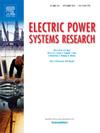Lightning-induced voltage on overhead conductors in urban areas: A study on how the air gap between buildings affects the shielding effect
IF 3.3
3区 工程技术
Q2 ENGINEERING, ELECTRICAL & ELECTRONIC
引用次数: 0
Abstract
Lightning-induced voltages significantly contribute to flashovers in medium-voltage (MV) overhead distribution lines. These voltages, generated by the electromagnetic fields of nearby lightning strikes, pose a substantial risk to system reliability and operational safety. The magnitude of these induced voltages strongly depends on the surrounding environment, particularly on the presence and characteristics of nearby objects. Nearby objects can influence the voltage waveform across pole insulators, either by altering its shape or attenuating its intensity. This study investigates the specific impact of the presence of air gaps between adjacent buildings on the induced voltage along MV lines placed in urban areas. By comparing scenarios involving separated buildings to those where a single continuous structure is considered, the research highlights how the structural configuration affects the line’s susceptibility to electromagnetic fields. To evaluate the impact, simulations are conducted using a Finite-Difference Time-Domain (FDTD) method-based solver. This computational approach enables detailed analysis of both the spatial variations in electric field strength and the temporal evolution of the induced voltage along the line. The results provide insights into the electromagnetic interactions between the distribution lines and their surrounding structures, offering valuable information for optimizing the design and layout of MV distribution systems to mitigate lightning-induced hazards.
城市架空导线雷击电压:建筑物间气隙对屏蔽效果影响的研究
在中压架空配电线路中,雷击电压是引起闪络的重要因素。这些电压由附近雷击的电磁场产生,对系统可靠性和运行安全构成重大风险。这些感应电压的大小很大程度上取决于周围环境,特别是附近物体的存在和特性。附近的物体可以通过改变其形状或减弱其强度来影响穿过极绝缘体的电压波形。本研究探讨了相邻建筑物间存在气隙对城市中压线路感应电压的具体影响。通过比较分离建筑和考虑单一连续结构的情况,研究强调了结构配置如何影响线路对电磁场的敏感性。为了评估影响,使用基于时域有限差分(FDTD)方法的求解器进行了模拟。这种计算方法可以详细分析电场强度的空间变化和感应电压沿线路的时间演变。研究结果揭示了配电线路及其周围结构之间的电磁相互作用,为优化中压配电系统的设计和布局以减轻雷击危害提供了有价值的信息。
本文章由计算机程序翻译,如有差异,请以英文原文为准。
求助全文
约1分钟内获得全文
求助全文
来源期刊

Electric Power Systems Research
工程技术-工程:电子与电气
CiteScore
7.50
自引率
17.90%
发文量
963
审稿时长
3.8 months
期刊介绍:
Electric Power Systems Research is an international medium for the publication of original papers concerned with the generation, transmission, distribution and utilization of electrical energy. The journal aims at presenting important results of work in this field, whether in the form of applied research, development of new procedures or components, orginal application of existing knowledge or new designapproaches. The scope of Electric Power Systems Research is broad, encompassing all aspects of electric power systems. The following list of topics is not intended to be exhaustive, but rather to indicate topics that fall within the journal purview.
• Generation techniques ranging from advances in conventional electromechanical methods, through nuclear power generation, to renewable energy generation.
• Transmission, spanning the broad area from UHV (ac and dc) to network operation and protection, line routing and design.
• Substation work: equipment design, protection and control systems.
• Distribution techniques, equipment development, and smart grids.
• The utilization area from energy efficiency to distributed load levelling techniques.
• Systems studies including control techniques, planning, optimization methods, stability, security assessment and insulation coordination.
 求助内容:
求助内容: 应助结果提醒方式:
应助结果提醒方式:


